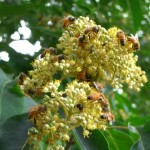EVERYONE is a BEEKEEPER
…. or not!
 Does your backyard have honeybees? Been wondering where have all the bees gone? YOU stopped keeping them! Using pesticides, herbicides, fungicides…. have you read the labels on how to apply? Does your yard look like a golf course? YOU stopped keeping bees!! The decline in the honeybee population correlates to the rise in chemical use in our agriculture practices. “Agriculture practices” includes using lawn services that kill clover, a common homeowner’s practice. The food sources for the honeybee have literally been almost eliminated. We are killing our honeybees by starving them and poisoning them.
Does your backyard have honeybees? Been wondering where have all the bees gone? YOU stopped keeping them! Using pesticides, herbicides, fungicides…. have you read the labels on how to apply? Does your yard look like a golf course? YOU stopped keeping bees!! The decline in the honeybee population correlates to the rise in chemical use in our agriculture practices. “Agriculture practices” includes using lawn services that kill clover, a common homeowner’s practice. The food sources for the honeybee have literally been almost eliminated. We are killing our honeybees by starving them and poisoning them.
What can you do?
1. Stop using lawn services and begin to consider a natural lawn is a beautiful lawn that feeds beneficial insects.
2. Set your lawn mower to cut at a higher height. Maybe even hold off mowing a day or so longer than you normally would.
3. Put the RoundUp away. At the very least, read the instructions on how to use and when to use. Late in the evening and non-windy days are the best times (if there is a best time).
4. Consider alternative natural weed killers like using vinegar or boiling water.
5. PLANT BEE ATTRACTING PLANTS! When you visit the home improvement stores and nurseries, notice which plants are being visited by honeybees. The bees will tell you which plants to buy.
Below is a partial list of bee-friendly plants, trees, shrubs and herbs as well as some further advice on planting a pollinating flower bed.
In recent years, Colony Collapse Disorder has caused an annual reduction of 30%-40% of bee colonies. Planting pollinator attracting plants help to provide food for not only the honeybee, but other pollinators such as butterflies.
Pollinator habitats are generally composed of both wildflowers and native perennials and annuals. A well-designed bed will have at least 2 species blooming all during the growing season.
Native bees are estimated to provide $3 billion in pollinating services in the US. In countries where the pollinators have been diminished to almost non-existence, pollination is being done by hand.
